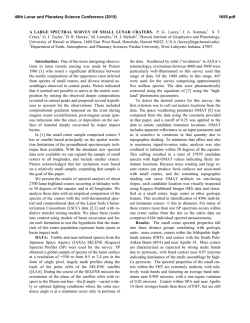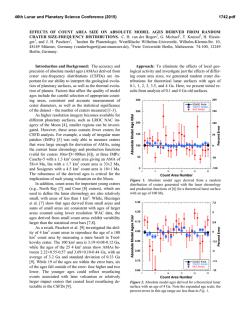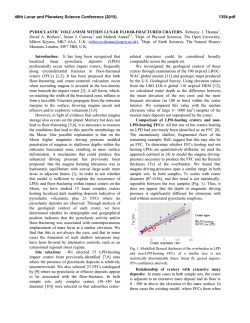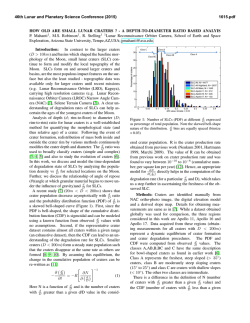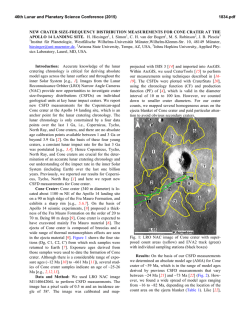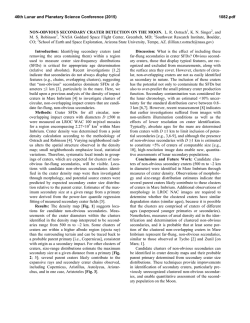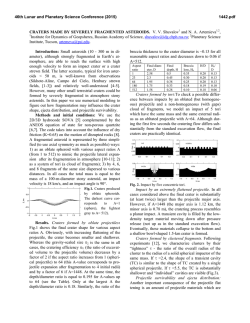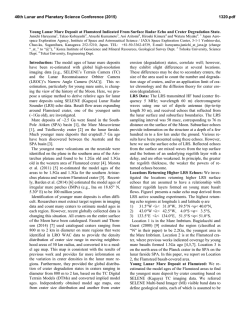
Distribution of Boulders at Different Types of Lunar Terrain
46th Lunar and Planetary Science Conference (2015) 1087.pdf DISTRIBUTION OF BOULDERS AT DIFFERENT TYPES OF LUNAR TERRAIN. E. N. Slyuta, Vernadsky Institute of Geochemistry and Analytical Chemistry, Russian Academy of Sciences, 119991, Kosygin St. 19, Moscow, Russia. [email protected]. Distribution of boulders at the Lunar maria: Distribution of boulders was studied in the landing area of the Soviet Lunokhod-1 in the western area of the Mare Imbrium [1, 2]. The images obtained by LROC (NASA) with a resolution of 0.72 m and a height of the Sun above the horizon 12.26º were used. Total area investigated is 8.68 km2. The diameter of the largest crater located on the study area and having coordinates 35.006 W and 38.284 N, is 456 m. Total boulders in size from 1.5 to 7 m in a given area was recognized 285. Only about 7% of them (20 boulders) are in the area between craters, which corresponds to density of boulders in the area between craters less than 2.3×10-4 per 100 m2. All other boulders are concentrated mainly at a rim and bottom of impact craters of different sizes. Concentration of boulders in size 1.5 m and more inside of the area of half the radius of the largest crater from its edge reaches 4.2×10-2 per 100 m2, and excluding the part of crater, hidden in the shadows (about one quarter of an area of the crater) 4.7×10-2 per 100 m2. It should be noted that hereinafter only considered boulders ranging in size from 1.5 m and more, since it is observed the sharp decrease amount of boulders smaller than 1.44 m due to limit of resolution of images. Mean cumulative number of boulders larger than a certain diameter N>D per 100 m2 at a lunar maria plain is described by the equation (Fig. 1) N>D=0.185D-3.8, (1) where D - diameter of boulders. Fig. 1. Cumulative density of distribution of boulders in size more than 1.5 m per 100 m2. ● – Lunar maria (the approximating line is shown by solid line); + Arustarchus Plato (the approximating line is shown by dashed line); ■ – Lunar highlands (the approximating line is shown by dash-dot line). Model data based on approximating line (Fig. 1) (Eq. 1) and the empirical data on cumulative density of boulders per 100 m2 are agree well (Table 1). That allows us to extrapolate the cumulative density of boulders smaller than 1.5 m (Table 1), inaccessible to study because of image resolution. It is obvious that knowledge of the size distribution of boulders within 0.2-1.5 m is also necessary for creation of a reliable engineering surface models. Table 1. Model and empirical cumulative density of distribution of boulders at Lunar maria Diameter, m 0.2 0.5 1.0 1.5 2.0 3.0 4.0 5.0 6.0 7.0 Model, N>D per 100 m2 83.80 2.58 0.185 0.039 0.013 0.0028 0.00095 0.00041 0.00020 0.00011 Empirical, N>D per 100 m2 0.033 0.018 0.0029 0.00092 0.00012 Distribution of boulders at the Aristarchus Plateau: Aristarchus Plateau is located in the Northwestern part of the Oceanus Procellarum, and is characterized by smoothed relief of highland areas surrounded by lunar maria. Distribution of boulders were studied on an image obtained LROC (NASA) with a resolution of 0.50 m and a height of the Sun above the horizon of 52.05º. The total size of the investigated area is about 4×5 km, total area - 19.38 km2. The diameter of the largest crater with coordinates of 48.627º W, 24.718 N, is 400 m. Boulders, compared with similar sized small craters are characterized by inverse arrangement of light and shadow and quite clearly recognized (Fig. 2). In general, the distribution of boulders is more homogeneous than in lunar maria. The highest density of distribution of boulders is observed at a crater of 90 m in diameter (Fig. 2). Density boulders' distribution more than 1.5 m in diameter inside area of one radius from the edge of the crater reaches more than 0.58 boulder per 100 m2. Mean density boulders' distribution outside of one radius from craters (between craters) is 7.9×10-3 per 100 m2, which is more than an order of magnitude above the analogous density at lunar maria (2.3×10-4 per 100 m2). Total boulders in a given area was recognized 1711 with a diameter more than 1.5 m. Mean cumulative density of distribution of boulders at Aristarchus plateau is described by equation (Fig. 1) N>D=0.596D-3.9, (2) 46th Lunar and Planetary Science Conference (2015) where D - diameter. Model (Fig. 1) (Eq. 2) and the empirical data on cumulative density of distribution of boulders per 100 m2 are agree well too (Table 2). Fig. 2. The distribution of boulders (a) in a crater of 90 m in diameter with coordinates of 48.600º W, 24.724º N. b) - Example of counting of boulders depending on their size (shown by red circles). Fragment of mosaic by LROC WAC (NASA). Table 2. Model and empirical cumulative density of distribution of boulders at Aristarchus Plato Diameter, m 0.2 0.5 1.0 1.5 2.0 3.0 4.0 5.0 6.0 7.0 Model, N>D per 100 m2 317.1 8.9 0.60 0.12 0.040 0.0082 0.0027 0.0011 0.00055 0.00030 Empirical, N>D per 100 m2 0.088 0.041 0.010 0.0035 0.0011 0.00046 0.00021 Distribution of boulders at the Lunar highlands: The investigated area is located on the back side of the Moon with coordinates at the center of image 158.624º W, 5.280º N. Resolution of images obtained by LROC (NASA), is 0.70 m, the height of the Sun above horizon - 42.73º. The size of the investigated area is 4825 × 4160 m, and area – 20.073 km2. Vertical drop in the area reaches up to 1000 m, and steepness of slopes reaches a few tens of degrees. Region is characterized 1087.pdf by smoothed slightly hilly surface. There are two large craters of 2 km and 1.7 km in diameter in the study area. Unlike Lunar maria plains and especially from Aristarchus Plateau, the distribution of boulders within the study area is strongly nonhomogeneous. The vast majority boulders are concentrated in only four regions. These are rims of two largest craters and two small craters of 320 and 240 m in diameter with coordinates 158.682º W, 15.251º N and 158.569º W, 5.252º N respectively. Total boulders more than 1.5 m in diameter in a given area was recognized of 1711. Boulders outside of one radius from craters (i.e. between craters) are very rare and the density (2.6×10-4 per 100 m2) is almost equal to the analogous density at the Lunar maria plains (2.3×10-4 per 100 m2). The highest concentration is observed at a rim of the crater of 220 m in diameter with coordinates 158.672° W, 5.282° N, which is superimposed to the rim of the largest crater of about 2 km in diameter. Concentration of boulders in size 1.5 m and more inside area of one radius from a crater reaches 0.20 boulders per 100 m2. Boulders are concentrated mainly at rims of both largest craters, but in craters of hundreds of meters in diameter boulders are mainly concentrated on the walls and bottom of craters. Mean cumulative density of distribution of boulders at the Lunar highlands is described by the equation (Fig. 1) (Table 3) N>D=0.693D-4.4, (3) Table 3. Model and empirical cumulative density of distribution of boulders at Lunar highlands Diameter, m 0.2 0.5 1.0 1.5 2.0 3.0 4.0 5.0 6.0 7.0 8.0 Model, N>D per 100 m2 824.5 14.63 0.693 0.116 0.033 0.0055 0.00155 0.00058 0.00026 0.00013 0.000074 Empirical, N>D per 100 m2 0.073 0.037 0.0072 0.0023 0.00080 0.00035 0.00010 0.000050 Summary: Lunar Maria is characterized by the lowest concentration of boulders with compared to the Aristarchus Plateau and the lunar highlands. Lunar highlands are characterized by twice the mean density in comparison with Lunar maria plains. The general concentration of boulders at Aristarchus Plateau is more homogeneous and almost three times higher than at Lunar maria plains. The concentration of boulders at Aristarchus Plateau between the craters is more than an order of magnitude than at lunar highlands and maria plains. References: [1] Florensky et al. (1971) In, Mobile laboratory on the Moon Lunokhod 1. Ed. A.P. Vinogradov. Moscow, Nauka. P. 96-115. [2] Florensky et al. (1972) In, Modern ideas about the Moon. Eds. K.P. Florensky, A.A. Gurshtein. Mosc. Nauka. P. 21-45.
© Copyright 2025

